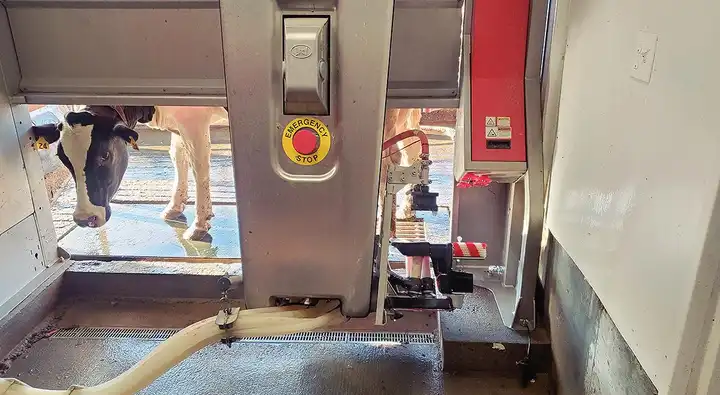
4 minute read
Wick Dairy utilizes a robotic milking system
from OFN June 15, 2020
by Eric Tietze
Dairy Embraces Technology By Terry Ropp
Wick Dairy utilizes evolving robotic milking system on their 375-cow dairy
Advertisement
Dominic Wick and his family immigrated to America from
Switzerland when he was 4. He was raised on a Stilwell, Okla., dairy farm while his wife Doylena was also raised on another in central Arkansas.
Doylena was well acquainted with the 24/7 demands of the dairy and told herself she would never marry a dairyman, but she did. Doylena met Dominic while she was working at Wick’s Dairy feeding baby calves.
Dominic graduated in 2014 from Oklahoma State University with a bachelors’ in plant and soil sciences and a minor in animal science.
“My education did not revolutionize our dairy, but it did provide me with tools and information to make incremental changes in terms of soil fertility, land quality and grazing rotation,” Dominic said.
Wick’s Dairy runs on nearly 1,000 acres with 375 milking cows and 10 employees, three of which are family.
Middle sister Denise manages the robotics and breeding heifers, while Dominic’s mother Heidy manages the calf barn and office, with Dominic being the general manager.
In 2018, Wick’s Dairy had a labor problem. Having been aware of the robotic milking systems through advertisements in dairy magazines and an open house tour of a robotic dairy a few years earlier, their labor issue nudged them to investigate the system in detail.
After touring the first robotic dairy in Oklahoma, Dominic contacted John King at Seneca Dairy Supply in Missouri.
“A critically important part of running a robotic-based dairy is reliable and speedy technical support,” Dominic
16
said. “You have to look at different dealers and talk to other robotic owners to find the best dealership for you because the dealer offers the first line of technical assistance. John King had exactly the product and service I needed.”
Wick’s Dairy’s system includes six Lely A4 robotic milking stations, with 55 cows per station being ideal. Each cow robots, it took us about six months to reach a profitable return, though we are still fine tuning,” Dominic said.
has a transponder which relays information to the Lely T4C software program. The software keeps track of everything from production per milking, which determines how much feed she gets during the next visit, to each cow’s activity level and rumination time. The system also diverts milk to buckets or the drain due to antibiotics or colostrum. It even refuses a cow who tries to return to the robot too soon in order to get more grain.
One of the challenges is figuring out the best genetics and nutrition for the greatest quantity and quality of milk using the robotic system. The Wicks’ cows are currently all Holstein, but Dominic began AI’ing replacement heifers with sexed
“After training the cows to the

Submitted Photos

Jersey semen. Jersey genetics will provide more butter fat and protein in the milk as part of improving herd genetics. Mature cows are exclusively AI’d with regular Jersey semen up to three times, after which they are bred with Angus semen to produce commercial beef calves. Bull calves are castrated at six months and raised Stilwell, Okla. to 500 to 700 pounds, then sold.
“Everything is about the cows with genetics being only one component,” Dominic explained. “The cow has to be happy, healthy and comfortable. The cows’ environmental needs have to be met and adjustments are ongoing.”
Wick’s Dairy mixes their own feed, buying raw ingredients such as corn and soybean meal. “Feed rations are developed in conjunction with our nutritionist, Dr. Gene Gengelbach from Agri-King in conjunction with Lely recommendations.” When changing to milking robots, they decreased the protein and energy content of their current feed and put it towards the feed the cows receive at the robot. This feed is mixed and pelletized, and then fed to the cows while they are being milked.
Land is used for three purposes: pasture for breeding heifers and dry cows, hay ground, and cropland for corn, wheat, alfalfa and sorghum. Land is soil tested and fertilized with cow manure. The 100 acres of alfalfa ground is fertilized with potash, as needed. The 300 acres set aside for raising corn for silage is double cropped with wheat and fertilized with cow manure, potash, and nitrogen fertilizer (UAN). Pastures are mostly fescue, Bermudagrass, Johnsongrass, ryegrass and brome, and are spot sprayed for thistles, while corn is sprayed twice with two different herbicides.
Dairy health protocols are another component of the successful operation and involve multiple rounds of herd vaccinations.
“I’m really happy with the Lely robotic system,” Dominic said. “The more units you buy the lower the cost due to maximizing external equipment like air compressors and central control units that run two robots each. We look forward to the future.”










